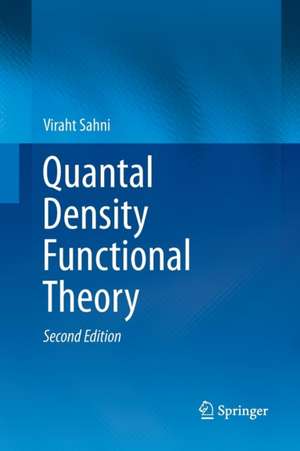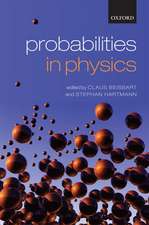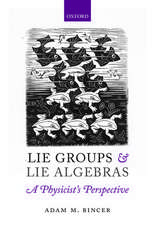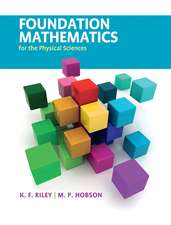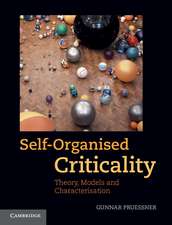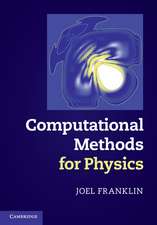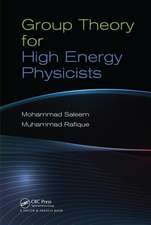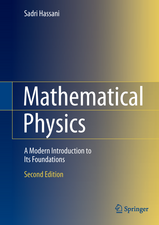Quantal Density Functional Theory
Autor Viraht Sahnien Limba Engleză Paperback – 12 iun 2018
| Toate formatele și edițiile | Preț | Express |
|---|---|---|
| Paperback (2) | 647.27 lei 6-8 săpt. | |
| Springer Berlin, Heidelberg – 12 iun 2018 | 647.27 lei 6-8 săpt. | |
| Springer Berlin, Heidelberg – 30 noi 2010 | 780.06 lei 6-8 săpt. | |
| Hardback (1) | 653.65 lei 6-8 săpt. | |
| Springer Berlin, Heidelberg – 19 aug 2016 | 653.65 lei 6-8 săpt. |
Preț: 647.27 lei
Preț vechi: 761.49 lei
-15% Nou
Puncte Express: 971
Preț estimativ în valută:
123.86€ • 129.91$ • 103.11£
123.86€ • 129.91$ • 103.11£
Carte tipărită la comandă
Livrare economică 01-15 aprilie
Preluare comenzi: 021 569.72.76
Specificații
ISBN-13: 9783662570395
ISBN-10: 3662570394
Ilustrații: XIX, 413 p. 71 illus., 20 illus. in color.
Dimensiuni: 155 x 235 mm
Greutate: 0.61 kg
Ediția:Softcover reprint of the original 2nd ed. 2016
Editura: Springer Berlin, Heidelberg
Colecția Springer
Locul publicării:Berlin, Heidelberg, Germany
ISBN-10: 3662570394
Ilustrații: XIX, 413 p. 71 illus., 20 illus. in color.
Dimensiuni: 155 x 235 mm
Greutate: 0.61 kg
Ediția:Softcover reprint of the original 2nd ed. 2016
Editura: Springer Berlin, Heidelberg
Colecția Springer
Locul publicării:Berlin, Heidelberg, Germany
Cuprins
From the Contents: Schrödinger Theory from the Perspective of ‘Classical’ Fields Derived from Quantal Sources.- Quantal Density Functional Theory.- The Hohenberg-Kohn Theorems and Kohn-Sham Density Functional Theory.- Physical Interpretation of Kohn-Sham Density Functional Theory.- Generalization of the Hohenberg-Kohn Theorem to the Presence of a Magnetostatic Field.
Notă biografică
Textul de pe ultima copertă
This book deals with quantal density functional theory (QDFT) which is a time-dependent local effective potential theory of the electronic structure of matter. The treated time-independent QDFT constitutes a special case. In the 2nd edition, the theory is extended to include the presence of external magnetostatic fields. The theory is a description of matter based on the ‘quantal Newtonian’ first and second laws which is in terms of “classical” fields that pervade all space, and their quantal sources. The fields, which are explicitly defined, are separately representative of electron correlations due to the Pauli exclusion principle, Coulomb repulsion, correlation-kinetic, correlation-current-density, and correlation-magnetic effects. The book further describes Schrödinger theory from the new physical perspective of fields and quantal sources. It also describes traditional Hohenberg-Kohn-Sham DFT, and explains via QDFT the physics underlying the various energy functionals and functional derivatives of the traditional approach to electronic structure.
Caracteristici
Presents a new edition of a well-reviewed book Gives a new understanding of QDFT in terms of classical fields Uses the Schrödinger theory from a new point of view Supports learning with great clarity of thought and consistency Displays a detailed roadmap of the basic ideas behind QDFT Delivers a large set of examples worked out in great detail and wonderfully illustrated Includes supplementary material: sn.pub/extras
Recenzii
"Gives physical insight because it renders the many-fermion problem in as close to a classical mechanical and electrodynamical form as can be imagined... It is an interesting, unconventional, and useful contribution to the DFT literature. "
-- INT. J. QUANTUM CHEM.
"This book shows how in an entirely new way, it becomes plausible to use the wave function within the broad context of DFT, thus redirecting the present computational approach of attempting to approximate the presently unknown, and thus largely mysterious, HK energy functional of the density. The claim is that the simplicity of the equations of DFT is retained on the one hand, while on the other hand, ridding them of their mystery, as contained in the Kohn-Sham (KS) local potential … The book describes all quantum systems, including atoms and molecules, in terms of the fields inherent to the systems deriving from their quantal sources. Indeed, an innovation of QDFT is to identify all such fields, and to explicitly write their dependence upon the various quantal sources. The result is a description of quantum chemistry that is as close to a classical description as one may imagine….
"All readers interested in how DFT fits within the larger theoretical structure of quantum theory will profit from this book. It marshals an effective argument for the existence of a specifically Q-DFT view of the density as cardinal object of quantum theory. To accept that argument in its entirety is to see Q-DFT as the fulfillment of the HK theorem promise, to turn the density into all the quantum properties of a chemical system. That in turn could lead to a conceptual and computational revolution within quantum chemistry, the like of which has not been seen since the original HK and KS papers of some 40 years ago." – J. CHEM. EDUCATION (L. Massa, CUNY)
-- INT. J. QUANTUM CHEM.
"This book shows how in an entirely new way, it becomes plausible to use the wave function within the broad context of DFT, thus redirecting the present computational approach of attempting to approximate the presently unknown, and thus largely mysterious, HK energy functional of the density. The claim is that the simplicity of the equations of DFT is retained on the one hand, while on the other hand, ridding them of their mystery, as contained in the Kohn-Sham (KS) local potential … The book describes all quantum systems, including atoms and molecules, in terms of the fields inherent to the systems deriving from their quantal sources. Indeed, an innovation of QDFT is to identify all such fields, and to explicitly write their dependence upon the various quantal sources. The result is a description of quantum chemistry that is as close to a classical description as one may imagine….
"All readers interested in how DFT fits within the larger theoretical structure of quantum theory will profit from this book. It marshals an effective argument for the existence of a specifically Q-DFT view of the density as cardinal object of quantum theory. To accept that argument in its entirety is to see Q-DFT as the fulfillment of the HK theorem promise, to turn the density into all the quantum properties of a chemical system. That in turn could lead to a conceptual and computational revolution within quantum chemistry, the like of which has not been seen since the original HK and KS papers of some 40 years ago." – J. CHEM. EDUCATION (L. Massa, CUNY)
